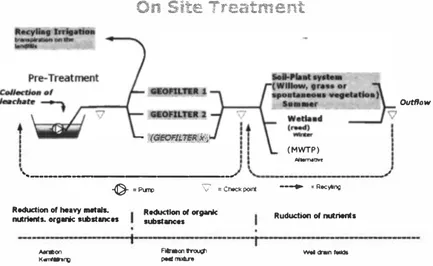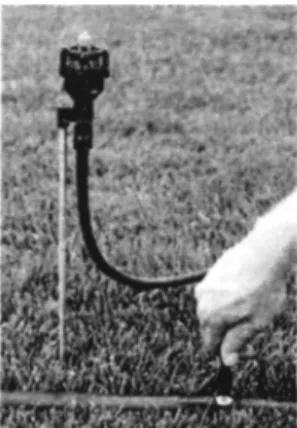4
KALMAR ECO-TECH'0I
Leachate and Wastewater Treatment with High-Tech and Natural systems KALMAR, SWEDEN, November 26-28, 2001
IRRIGATION BASED LEACHATE
TREAT-MENT
Dahn Rosenqvist
Rosenqvist Mekaniska Verkstad AB
Gringelstadsviigen 118, 291 97 Giirds Kopinge, Sweden
ABSTRACTIn southern Sweden, several irrigation based on site treatment has been established the last years. Briefly they consist of a pound to storing leachate water with pre-treatment and a system what irrigate vegetation. It could be areas of willow plantations designated for en ergy purposes or grass or as in same cases spontaneous vegetation.
The use of willow have been studied since 1992. These tests have clearly shown that recy cling of municipal wastewater in Salix plantations, can replace a large part of the conven tional wastewater treatment, due to natural purification processes in the soil/plant system. During the last few years, several full-scale treatment plants based on the soil/plant system have been set up to treat leachate water from municipal solid waste (MSW) landfills. One other way to reduce leachate water is to use transpiration. On dry days leachate is pumping and irrigated ideal on top of landfills inside the leachate collection system. Rosenqvist Mek.Verkstad has developed the irrigation system "RWIS" for distribution of waste and leachate water into the plantation. The irrigation system has to be able to with stand trying conditions, without major maintenance in between harvests.
INTRODUCTION
Special conditions apply to irrigation design for this waters. This requires a system that satisfies the following conditions:
• Potential aerosol leakage must be eliminated.
• Harvesters must be able to move freely, without the system being dismantled (option) • Low running costs
• Low maintenance costs
• Can be integrated with other water/sewerage systems
Dahn Rosenqvist, Sweden
55
-_-_-_-_-�_-_
fr--==----Dam.e-
�•-·s:=========t=========
!-------
1
ru---:••�
KALMAR ECO-TECH'0ILeachate and Wastewater Treaonent with High-Tech and Natural systems KALMAR, SWEDEN, November 26-28, 200 I
RWIS is a concept based on root zone watering. The technology is a type of controlled flooding, combined with broad irrigation.
On Site Treatment
-�
·---
(MWTP)""""""
Out/low ___.. :Rec�ng V = Cheekpoirt -@·"""Roducllon of heavy - Reduction of organic Rududlon ol nutrients
rurients. organic substances subslancn
....
·-
...,
Flhlon...,,...
w.ldrwnr.lds�Dltl'I�
Figure 1. Show where irrigation comes in on a landfill
RWIS
From pre-treatment the water pwnped through an underground duct to the willow field. The duct, which can supply one or more fields with water at the same time, is connected to a trunk pipe under the Salix field. Electrically operated valves, one for each module, are mounted on the trunk pipe. The module comprises a trunk pipe (underground) with, on
-Pump
",
LJ
,--fT
---r---._
...
_____
��������������I�������������;
---t---·Figure 2. Principe schema R WIS
either side, 12 supply pipes with drilled holes (an arrangement similar to the veins in a
Dahn Rosenqvist, Sweden
57
KALMAR ECO-TECH
·
o
ILeachate and Wastewater Treatment with High-Tech and Natural systems
KALMAR, SWEDEN, Novembcr26-28, 2001
leaf). The supply pipes lie on the soil surface. Allowing the water to flow out at ground
level, minimises odour and sanitary problems, and avoids the formation of aerosol. By util
ising the horizontal transport of water by the soil and by flooding to exploit undulations of
the terrain, the distances between the supply pipes can be made relatively large. Salix have
long roots (10 metres or more) and will seek out water and nutrients. Experiments in
KAgerod and Bromolla show that the effect on the groundwater is minimal.
Recycling Irrigation
This system is very much like the R WIS system but in
stead of hols there are sprinkler. Normally used sprinkler
is a plastic rotators. This sprinkler have the right combi
nation of radius, uniformity and diffused stream. Depend
ing on climate 20-50% of rainfall is possibly to transpira
tion. That is recommended to locate the system on the
landfill. As the system is very easy to move also tempo
rary arias on the landfill could bee used and also get a
possible effect on the landfillgas production.
Figure 3 : Rotator R2000
Irrigation amounts
The KAgerod experiments indicate that an appropriate water irrigation rate is about
6 mm/day, which gives the heights biomass production. Rates up to 12 mm/day have been
tested. The reduction of total N was 82-93%, 90-97 % of total P and 74-82% of BOD. The
irrigation should follow the vegetative period of the Salix. Normally, the vegetative period
begins in May and ends in September-October, depending on the location . Especially to
wards the end of the period, the nitrogen content should be reduced to avoid frost damage.
When designing a RWIS, you must consider what is add with the sewage and removed
with in the harvest, to maintain the balance of nutritional requirement.
During the non-vegetative period, the water is held in ponds or treated in a conventional
treatment plant. Calculations show that, even with the costs of holding ponds, the plant
based sewage treatment method can compete with conventional treatment technology.
Control system
The combination of simple equipment and advanced computer-controlled irrigation gives:
• Optimal growth with maximum nutrient absorption
• Minimal running costs
• Minimal maintenance costs
• Documentation and follow-up
When distributing sewage, it is essential to know where the water goes! This makes de
mands on the irrigation technology. Using a control system, which takes into account,
KALMAR ECO-TECH'0l
Leachate and Wastewater Treatment with High-Tech and Natural systems KALMAR, SWEDEN, November 26-28, 2001
pography, soil type, sewage quality and external precipitation solves the problem. Informa tion for reporting to authorities is saved and compiled in the system.
There is also an advanced function monitoring system, which minimises the need for main tenance. The control system can be a self-contained unit, or be integrated with the central water/sewage control system.
REFERENCES
l. Aronsson, P. & Perttu, K (Eds.). 1994. Willow vegetation filters for municipal wastewaters and sludges - A biological purification system. Proceedings of a study tour , conference and workshop in Sweden, 5-10 June 1994. Swed. Univ. Agric. Sci., Dept. Short Rotation Forestry, Uppsala. Rep. 50,230 pp.
2. Aronsson, P. & Perttu, K. 1994. A complete system for wastewater treatment us ing vegetation filters. In: Aronsson, P. & Perttu, K (Eds.). Willow vegetation fil ters for municipal wastewaters and sludges - A biological purification system. Proceedings of a study tour , conference and workshop in Sweden, 5-10 June 1994, pp. 211-213.
3. Bergkvist P. &, Slam i energiskog (Sludge in energy forest), Agricultural Univer sity of Sweden, Fakta-Mark/vl!xt, no. 5, 1995
4. Perttu, K. & Koppel, A. (Eds.). 1996. Short rotation willow coppice for renewable energy and improved environment. Proceedings of a joint Swedish-Estonian seminar on on Energy forestry and vegetation filters held in Tartu 24-26 Septem ber 1995. Swed. Univ. Agric. Sci., Dept. Short Rotation Forestry; Uppsala. Rep. 57, 172 pp.
5. Perttu K.L., 1994, Vegetationsfilter av salix renar vatten and mark (Salix vegeta tion filters clean up water and soil). Agricultural University of Sweden, Skogs fakta no. 9, 1994.
6. Hasselgren K., 1999, Bevattning av energiskog med forbehandlat avloppsvatten.
Rapport V A-Forsk I 999-5
7. Hasselgren K., 1998, Bevattning av energiskog med biologiskt behandlat av loppsvatten. Slutrapport till stiftelsen Lantbruksforskning, Projekt 957837
8. Hasselgren K., 1994, Kommunalt avloppsvatten - en resurs i energiskogsodling (Public sewage - a resource in energy forest cultivation). Cirkulation 3(5): 6-8 Svalov
9. Rosenqvist D., 1998 , RWIS Rosenqvist Wastewater Irrigation System. Folder, Rosenqvist Mekaniska Verkstad AB
10. Rosenqvist, H., Aronsson, P., Hasselgren, K. & Perttu, K. 1997. Economics of us ing municipal wastewater irrigation of willow coppice crops. Biomass and Bio energy, Vol. 12,No. 1:1-8.
11. Stenstrom, T A. 1996. Sjukdomsframkallande mikroorganismer i avloppssystem. Riskvlirdering av traditionella och altemativa avloppslosningar. SNV Rapport 4683.
Dahn Rosenqvist, Sweden

